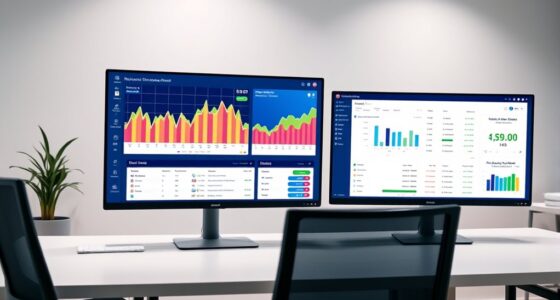Virtual terminals can transform how you manage payments in your small business. They let you accept credit card payments online or over the phone, giving you flexibility and convenience. Plus, you can lower your transaction fees, enhancing your profit margins. With added security features like tokenization and PCI compliance, you can protect your customer's data effectively. You won't need expensive hardware, making it a cost-effective solution for your operations. Overall, virtual terminals simplify payment processes and improve customer satisfaction. If you're curious about how to set one up, there's plenty more to explore.
Key Takeaways
- Virtual terminals enable small businesses to accept payments online, via phone, or in-person without needing physical hardware, enhancing payment flexibility.
- Lower transaction fees and elimination of hardware costs make virtual terminals a cost-effective solution for improving profitability.
- Enhanced security features, including tokenization and PCI DSS compliance, protect customer data and reduce the risk of fraud.
- Businesses can manage recurring billing automatically, simplifying cash flow and reducing administrative burdens associated with payment processing.
- Virtual terminals support diverse payment methods, catering to varied customer preferences and fostering repeat business.
Understanding Virtual Terminals

When it comes to processing payments, many small businesses are turning to virtual terminals for their convenience and efficiency. A virtual terminal is a web-based application that allows you to accept credit card payments without needing physical hardware. All you need is an internet connection and a merchant account to get started.
This payment processing solution is versatile, enabling you to process various payment methods, including debit cards, ACH transactions, and even recurring payments. Additionally, using a virtual terminal can facilitate nationwide business growth and sales increase, making it an attractive option for small business owners looking to expand their reach. For more insight on merchant account credit processing, the benefits are clear.
For small businesses, virtual terminals offer a cost-effective choice with lower transaction fees compared to traditional methods. The setup process is quick and straightforward, so you can start accepting payments almost immediately after payment provider approval.
Moreover, enhanced security features are built into virtual terminals, including encryption and tokenization, ensuring that sensitive customer data remains protected during transactions. Compliance with PCI DSS standards further solidifies the security of your payment processes.
Key Advantages for Small Businesses

When you use virtual terminals, you gain enhanced payment flexibility, allowing your customers to pay in a way that suits them best.
This convenience can lead to increased sales and customer satisfaction, especially when combined with effective fraud prevention tools that enhance transaction security.
Plus, you'll enjoy cost-effective transactions with no hefty upfront investments, making it easier for your small business to thrive.
Enhanced Payment Flexibility
Embracing the power of virtual terminals can greatly enhance payment flexibility for small businesses. By leveraging these tools, you can:
- Accept payments through various channels, including phone, email, and online platforms.
- Facilitate recurring billing, simplifying cash flow management and increasing customer retention, which is essential for maintaining a healthy budget.
- Support mobile transactions, allowing you to process payments from anywhere, at any time.
With virtual terminals, you're not just simplifying credit card processing; you're expanding your payment options. By supporting multiple payment methods, including credit/debit cards and ACH transactions, you reduce the risk of lost sales due to limited choices.
The user-friendly interface of virtual terminals makes it easy for you to adapt to changing payment needs, ensuring a seamless transaction experience.
Moreover, the enhanced payment flexibility offered by virtual terminals greatly boosts customer convenience. Whether you're accommodating on-the-go transactions or meeting clients directly, you'll find it easier to keep your operations smooth and efficient.
This adaptability fosters greater customer satisfaction and loyalty, ultimately benefiting your small business in the long run. Embrace virtual terminals, and watch your business thrive with newfound payment capabilities!
Cost-Effective Transactions
Cost-effective transactions are essential for small businesses looking to maximize their profits while minimizing expenses. Virtual terminals provide a great solution for this, as they typically offer lower transaction fees compared to traditional payment processing methods. By saving on these costs, you can enhance profitability and allocate resources more effectively.
Additionally, efficient payment solutions can further streamline your operations, allowing for seamless integration with existing systems.
Moreover, virtual terminals eliminate the need for expensive physical hardware, making them financially accessible for startups and small businesses. They allow you to process various payment types, such as credit cards, debit cards, and ACH transactions, helping you cater to a broader customer base and reduce potential lost sales.
Faster fund availability is another significant advantage. With quicker transaction processing, you can enjoy improved cash flow, which is crucial for your business's financial health.
Additionally, features like automated recurring billing streamline payment collection processes, minimizing administrative burdens and enhancing operational efficiency.
Enhanced Security Features

Enhanced security features are a standout benefit of virtual terminals for small businesses. By implementing robust security measures, you can protect your transactions and build customer confidence. Given the rise in cybersecurity threats, such as those observed during the recent Microsoft Outage Impact, it's essential to fortify your systems.
Here are three key enhancements:
- Tokenization: This technique replaces sensitive payment data with unique identifiers, considerably reducing the risk of data breaches during transactions.
- PCI DSS Compliance: Adhering to these standards guarantees secure handling of cardholder information, minimizing your liability as a merchant.
- Two-Factor Authentication (2FA): This adds an extra layer of security by requiring a second form of verification, making unauthorized access to accounts much harder.
Additionally, features like Card Verification Value (CVV) and Address Verification Service (AVS) help verify the identity of cardholders, enhancing transaction legitimacy and aiding in fraud prevention.
With continuous monitoring and regular updates of security protocols, virtual terminals stay resilient against evolving cyber threats. By prioritizing these enhanced security features, you not only protect your business but also reassure your customers that their information is safe.
Investing in virtual terminals is an effective way to safeguard your operations and foster trust in your payment processing.
Cost Efficiency and Savings

One of the most compelling advantages of virtual terminals for small businesses is their cost efficiency. By utilizing virtual terminals, you can benefit from lower transaction fees compared to traditional payment methods. This reduction markedly cuts down your overall processing costs, allowing more budget to be directed toward essential operational expenses.
Additionally, efficient e-commerce credit card processing can help to maximize these savings even further.
Additionally, the elimination of physical hardware requirements leads to substantial upfront savings. You won't have to invest in expensive equipment, providing you with an immediate financial boost.
Faster transaction processing enhances your cash flow, giving you quicker access to funds than traditional invoicing methods typically allow.
Virtual terminals also support automated recurring billing, which minimizes the time spent on manual entries and reduces labor costs associated with payment processing. This streamlining means you can focus on growing your business rather than managing payments.
Moreover, many virtual terminal providers offer transparent pricing structures with no hidden fees. This clarity empowers you to accurately forecast your payment processing costs, improving your financial planning.
Flexibility and Accessibility

With virtual terminals, you gain the freedom to accept payments anytime and anywhere, transforming how you do business. This flexibility and accessibility are vital for small businesses aiming to thrive in today's competitive market. Here are three key benefits:
- Operational Convenience: You can process payments through any internet-connected device, eliminating the need for bulky payment hardware. This efficiency is similar to how routine health checks are essential for maintaining pet well-being, ensuring your business runs smoothly.
- Diverse Customer Preferences: Virtual terminals enable you to cater to a wide range of payment methods, including credit/debit cards and ACH transactions, enhancing customer satisfaction.
- Empowering Mobile Professionals: If you're often on the go, virtual terminals let you complete transactions on-site, whether you're traveling or attending events.
The user-friendly interface of virtual terminals makes it easy to manage sales records and access valuable business insights. This means you can make informed decisions from virtually anywhere.
Top Virtual Terminal Solutions

Choosing the right virtual terminal solution can greatly impact your small business's payment processing efficiency.
For instance, Elavon Virtual Terminal is ideal for businesses operating internationally, as it offers multi-currency support, PCI compliance, and 24/7 customer support. Additionally, it's essential to avoid gold IRA scams when dealing with financial transactions to protect your investments.
If you need thorough payment method support, Worldpay Virtual Terminal is a scalable option that includes robust fraud management tools, making it suitable for businesses of all sizes.
NMI Virtual Terminal stands out with its customizable API, allowing you to tailor your payment processing experience, along with real-time transaction monitoring to keep you updated.
If security is a top priority, consider Cybersource Virtual Terminal, recognized for its advanced fraud detection capabilities and global reach, ensuring your transactions remain secure.
Lastly, Mastercard Payment Gateway Services (MPGS) includes detailed reporting tools and multi-currency support, enabling you to analyze transactions effectively across different markets.
Setting Up a Virtual Terminal

Setting up a virtual terminal is a straightforward process that can quickly improve your small business's payment capabilities. By following these simple steps, you can integrate this powerful tool into your operations:
- Complete an online application with a payment processor to get started. Understanding the financial implications of your payment processing choices is essential for long-term success, especially if you plan to create a retirement savings plan.
- Configure your merchant account credentials to establish secure payment processing.
- Access training and support from your provider to guarantee smooth operation.
Most virtual terminal providers don't require any upfront investment in hardware or software, markedly lowering the financial barrier for small businesses.
Once you're approved, you'll gain access within a few days, allowing you to start processing payments without delay.
The user-friendly interface means you can operate the terminal from any internet-connected device, making it easy to manage transactions on the go.
Plus, many providers offer ongoing training and support, ensuring your staff can efficiently handle customer interactions and payments.
With minimal technical expertise needed, setting up a virtual terminal can be a game-changer for your business, enhancing your payment processing capabilities and customer service.
Frequently Asked Questions
Can Virtual Terminals Handle International Transactions?
Yes, virtual terminals can handle international transactions. They support multiple currencies and payment methods, allowing you to accept payments from customers around the world seamlessly. Just guarantee your provider offers the necessary features for international processing.
What Types of Businesses Benefit Most From Virtual Terminals?
Ever wondered how your business could thrive with seamless transactions? Service providers, e-commerce shops, and mobile vendors benefit most from virtual terminals, as they streamline payments and enhance customer satisfaction in an increasingly digital world.
Are There Transaction Limits for Using Virtual Terminals?
Yes, there're often transaction limits when using virtual terminals, which can vary by provider. It's important to check your specific service terms to understand these limits and how they might affect your business transactions.
How Do Virtual Terminals Integrate With Accounting Software?
Integrating virtual terminals with your accounting software is like syncing a perfectly tuned orchestra. You streamline transactions, automatically update records, and reduce manual errors, making your financial management smoother and more efficient than ever.
What Customer Support Options Are Available for Virtual Terminal Users?
You've got several customer support options for virtual terminal users. Most providers offer live chat, phone support, and email assistance. Many also have extensive online resources like FAQs and video tutorials to help you troubleshoot issues.
Conclusion
To sum up, embracing virtual terminals can be a game-changer for your small business. They offer a modern solution that simplifies transactions while keeping your finances secure. With their cost-effective nature and flexibility, you're not just investing in a tool; you're nurturing growth and innovation. So, as you consider enhancing your payment processes, remember that virtual terminals are more than just a convenience—they're a strategic ally in your journey toward success.










